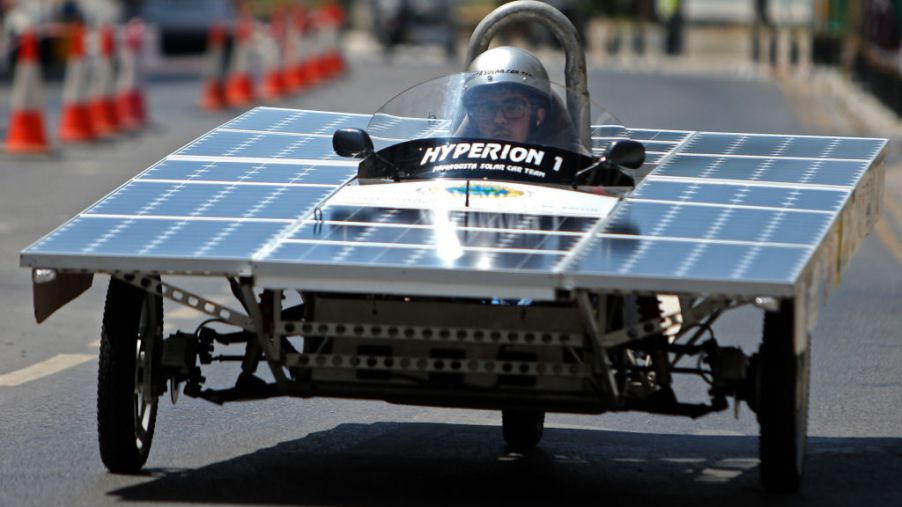
Should You Put Solar Panels on the Roof of Your Car — or Is It a Waste of Money?
Is there a way to make your electric car even more efficient? Some believe solar panels are the way to make their electric cars even greener or lower pollution. Will the addition of solar panels really make your electric car more efficient?
How green can your electric car be?
How much pollution an electric car puts out depends on where it gets its energy. The state you live in determines the energy grid you have access to.
Each state in the U.S. has its own energy mix. There are two mixes: consumption and generation. There are different quantities because companies buy energy from some states and sell it to other states.
It won’t be easy to make your car greener if your state’s energy is mostly coal. Most states are coal dominated but most of the population is not. Coal provides 30% of U.S. electricity with fossil fuels providing 63%. 20% of U.S. energy comes from nuclear generation, 7.5% from hydro, 6.3% from wind, and only 1.3% from solar.
Cars that strictly use gasoline put out 20 lbs (8,887 grams) of CO2 for each gallon used. There are other pollutants expelled too like NO2 and other small particles. The smaller particles are actually the worst part. They can kill people whose bodies can’t negotiate lung inflammation.
When it comes to greenhouse gases per kilowatt-hour (kwh), the U.S. is responsible for 500 grams per kwh. The average U.S. car gets 22 miles per gallon of gas. That’s an output of 8,890 grams of greenhouse gases for gasoline compared with 2,700 grams for electric cars. When you charge from a local grid, the local mix seems to control your emissions.
Is there any way you can improve your car’s efficiency with solar?
Solar panels for your house
Some rush out to mount solar panels on their house. They imagine their electric car using solar energy.
Not so fast.
The only benefit adding solar panels to your grid-tied home brings is the reduction of emissions due to grid electrical generation. The air will be a little better and the grid a bit greener. But that’s all it does.
There’s no impact on your electric car. Energy generated is sun-based and it’s the same energy whether or not you drive. The more you charge your car, the more net energy pulls from the grid to your house. The less you drive, the less grid energy used.
Solar panels may not reduce the pollution your electric car puts out. They are still a good and responsible idea though. They can save you money and again, make the grid a bit more renewable.
Solar and local home storage
Some believe that combining local home storage (think devices like Tesla’s Powerwall) with solar is a good idea. Storage devices like Powerwall allow you to save some of the solar energy harvested through the day and use it for power at night. The method, if applied right, can save you money.
However, once you install the system, the more energy used (driving in particular), the more you draw on grid generated energy. In a grid-tie setup, there aren’t any solar electrons. Just grid electrons and your batteries and solar panels are all part of the latter.
Solar panels on the car
Can’t electric cars just use solar roofs to power them for free?
It’s not that easy. For a short period of time, Tesla CEO Elon Musk announced there would be a solar roof option for Model 3. He backpedaled on the statement not long after in July 2017.
“Putting solar panels on the car itself? Not that helpful, because the actual surface of the car is not that much, and cars are often inside. The least efficient place to put solar is on the car.”
It was discovered there had been plans for solar roofs that came from the trunk and extended over the car.
The Karma Revero, a Tesla competitor, does have a solar roof option. The use of solar panels in electric cars isn’t as efficient as it needs to be. An automotive solar roof could generate 15 to 20% of the energy they harvest. If the Revero gets eight hours of good sunshine, it will harvest enough solar energy to drive about a mile and a half.
If you charge Model 3 for eight hours from an electrical socket, you get over a 200-mile range.
The grid and your electric car
As more solar enters the grid, it ends up being more variable. It would seem like a good thing to reduce the use of non-renewable energy within the grid. But the lower emission fossil fuel plants can’t turn on and off instantly. The grid is then forced to use plants with higher emissions to balance the variable load.
Hopefully, methods and technologies for the grid will develop to create a beneficial relationship between solar energy and electric cars.


